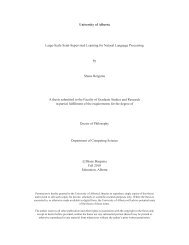The high altitude wildlife areas of western Arunachal Pradesh
The high altitude wildlife areas of western Arunachal Pradesh
The high altitude wildlife areas of western Arunachal Pradesh
You also want an ePaper? Increase the reach of your titles
YUMPU automatically turns print PDFs into web optimized ePapers that Google loves.
Chinese goral<br />
Appendix 1<br />
Discovery <strong>of</strong> the Chinese goral Nemorhaedus caudatus in<br />
<strong>Arunachal</strong> <strong>Pradesh</strong>: another addition to the large<br />
mammals <strong>of</strong> the Indian sub-continent<br />
Abstract<br />
<strong>The</strong> <strong>wildlife</strong> <strong>of</strong> the <strong>high</strong> <strong>altitude</strong>s (>3000 m) <strong>of</strong> <strong>Arunachal</strong> <strong>Pradesh</strong> has remained poorly explored. We<br />
undertook a survey to document the status <strong>of</strong> <strong>high</strong> <strong>altitude</strong> <strong>wildlife</strong> <strong>of</strong> Tawang and West Kameng<br />
Districts <strong>of</strong> <strong>Arunachal</strong> in August-September 2003. Here, we report the discovery <strong>of</strong> the Chinese goral<br />
Nemorhaedus caudatus in Western <strong>Arunachal</strong>, which represents a new addition to the list <strong>of</strong> large<br />
mammals <strong>of</strong> the Indian sub-continent. This discovery makes our survey area perhaps the only region in<br />
the world known to harbour all three extant species <strong>of</strong> goral (Chinese, Himalayan N. goral, and red goral<br />
N. baileyi). Together with the red goral, the Chinese goral is categorized as ‘Vulnerable’ in the IUCN’s Red<br />
List <strong>of</strong> Threatened Species, and we recommend the inclusion <strong>of</strong> both these species in Schedule I <strong>of</strong> the<br />
Indian Wildlife (Protection) Act.<br />
Introduction<br />
Ungulates are believed to be amongst the best documented taxa <strong>of</strong> large <strong>wildlife</strong>, with<br />
only ten new species being described between 1930 and 1994 1 . Yet, the past decade<br />
saw a spate <strong>of</strong> ungulate discoveries in Southeast Asia, with four species new to science<br />
being described between 1994 and 1998 2-5 . <strong>The</strong>se new discoveries reflect the hitherto<br />
poor status <strong>of</strong> exploration and documentation <strong>of</strong> <strong>wildlife</strong> in the remote Southeast<br />
Asian forests. Within India, the <strong>wildlife</strong> <strong>of</strong> the northeastern state <strong>of</strong> <strong>Arunachal</strong><br />
<strong>Pradesh</strong> (26°28'– 29°30'N and 91°30'– 97°30'E; 83,743 km²) has remained poorly<br />
documented. One <strong>of</strong> our surveys in 2002 resulted in the discovery <strong>of</strong> the leaf deer<br />
Muntiacus putaoensis in <strong>Arunachal</strong>, a new species that was first found in the adjoining<br />
forests <strong>of</strong> Myanmar as recently as 1997 3,5,6 . This discovery <strong>of</strong> the leaf deer in the midelevation<br />
forests <strong>of</strong> Eastern <strong>Arunachal</strong> was so far the only new addition to the list <strong>of</strong><br />
large mammals <strong>of</strong> the Indian sub-continent in the last century 6 .<br />
<strong>Arunachal</strong> <strong>Pradesh</strong> is situated in the transition zone between the Himalayan<br />
and Indo-Burmese regions 7,8 . <strong>The</strong> entire state is featured within the Eastern Himalaya<br />
global biodiversity hotspot 9,10 as well as among the 200 globally important<br />
ecoregions 11 . Most <strong>wildlife</strong> surveys in <strong>Arunachal</strong> so far have been restricted to lowand<br />
mid-elevation forests 6,12-16 . Apart from a recent survey <strong>of</strong> pheasants in midelevation<br />
and alpine <strong>areas</strong> that led to the discovery <strong>of</strong> a possibly new species <strong>of</strong><br />
pheasant 14 , the status and the occurrence <strong>of</strong> <strong>high</strong> <strong>altitude</strong> (> 3000 m) <strong>wildlife</strong> remains<br />
largely unknown. This is so despite the fact that 23 % <strong>of</strong> the state’s land area is at<br />
elevations over 3000 m.<br />
We undertook a biological expedition in the <strong>high</strong> <strong>altitude</strong> <strong>areas</strong> <strong>of</strong> Western<br />
<strong>Arunachal</strong> with the objective <strong>of</strong> inventorying <strong>wildlife</strong>, and identifying <strong>areas</strong> for<br />
possible designation as <strong>wildlife</strong> reserves. This survey, conducted in August-September<br />
2003, covered almost the entire <strong>high</strong> <strong>altitude</strong> <strong>areas</strong> <strong>of</strong> Tawang and West Kameng<br />
Districts. Here, we report a significant finding <strong>of</strong> the survey: the occurrence <strong>of</strong> the<br />
Chinese goral N. caudatus (also called long-tailed goral) in Western <strong>Arunachal</strong><br />
29

















